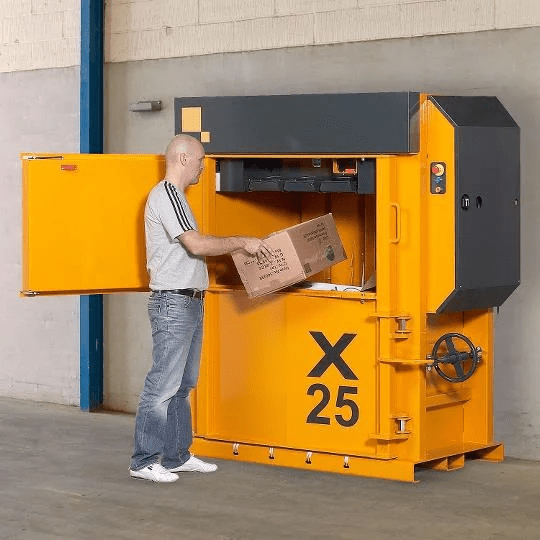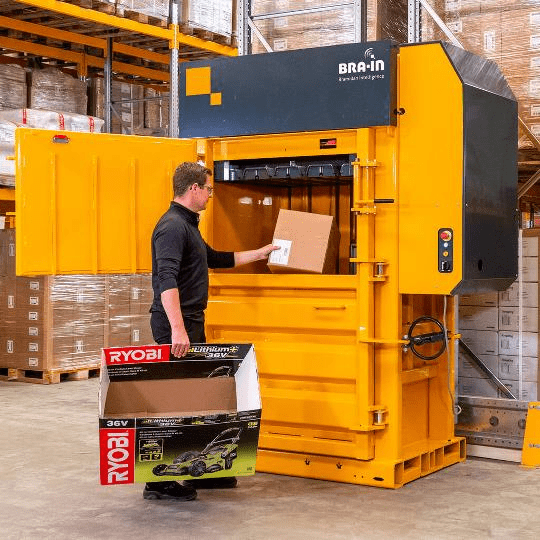CALL NOW FOR A FREE QUOTE 866.760.8194
What Can You Put in a Commercial Baler?
Commercial balers are essential tools for managing waste in industries such as retail, manufacturing, and warehousing. They help compact bulky materials into manageable bales, making storage, transport, and recycling easier and more efficient. But not all materials are suitable for baling, and misusing a baler can lead to machine damage, safety hazards, or contamination of recyclable materials.
Below, we’ll outline what you can and can’t put in a commercial baler machine, along with tips for safely operating your recycling baler.
Common Materials You Can Put in a Commercial Baler
Understanding which materials work best with your baler helps maximize efficiency while protecting your equipment and maintaining high-quality recyclable output.
Cardboard
Cardboard is the most commonly baled material in commercial settings. Bales of cardboard include boxes, shipping cartons, and corrugated packaging. Before baling, ensure all cardboard is dry and free from excessive tape, staples, or plastic liners to maintain the purity of the recycling stream.
Paper Products
Many types of clean, dry paper are suitable for baling. This includes printer paper, newspapers, office paper, magazines, and shredded paper. Baled paper can include mixed paper waste, although keeping grades separated improves recycling value.
Plastics
Certain types of plastic are baler-compatible, depending on the machine. Bales of plastic often include shrink wrap, stretch film, PET bottles, HDPE containers, and some rigid plastics. When creating your baled plastics, always verify the type of material and remove any food residue or contaminants before processing.
Aluminum and Other Metals
With the right type of baler—typically a heavy-duty or industrial-grade model—light metals like aluminum cans and thin sheets can be compacted. These machines are designed to handle the higher pressure required for metal, but it’s crucial not to overload them or include unapproved metals when creating bales of aluminum.
Materials You Should Not Put in a Commercial Baler

Knowing what to avoid is just as important as knowing what you can bale, as the wrong materials can damage equipment, create safety hazards, or contaminate your recyclables.
Hazardous Waste (e.g., Batteries, Electronics, Chemicals)
Under no circumstances should hazardous waste go into a baler machine. This includes batteries, electronic devices, chemical containers, and anything flammable or toxic. These items pose serious fire, health, and environmental risks and must be disposed of following local hazardous waste regulations.
Wet, Greasy, or Food-Contaminated Materials
Moisture and organic contamination can compromise the structural integrity of bales and lead to mold, odors, or pest issues. Keep all materials clean and dry to maintain quality and avoid contamination of recyclables.
Glass
Glass is too brittle and sharp for standard recycling balers, risking serious injury and mechanical damage. Instead, glass should be handled using specialized glass recycling containers or systems.
Wood or Large Metal Parts
Bulky items like wood pallets, construction debris, or heavy metal parts are not suitable for standard balers. These materials require specialized equipment designed to handle their size and density. Using the wrong baler for these items can cause jams, breakdowns, or structural damage.
Tips for Efficient and Safe Baling

Following these best practices will help you get the most out of your baler while ensuring safe operation and consistent, high-quality results.
1: Always follow the baler’s manufacturer guidelines.
Each baler has specific capabilities and limitations. Read and adhere to the manufacturer’s instructions to prevent misuse and prolong the life of equipment.
2: Train staff on proper material sorting and baling procedures.
Proper training ensures safety and improves recycling efficiency. Staff should be able to recognize which materials are suitable for baling and how to operate the machine correctly.
3: Keep materials dry and remove contaminants before baling.
Moisture and contaminants like food waste, oil, or hazardous substances can render bales non-recyclable. Pre-sorting and cleaning materials before baling will maintain quality and ensure compliance with recycling facility requirements.
4: Schedule regular maintenance to prevent costly breakdowns.
Like any heavy machinery, balers require routine inspection and maintenance. Regular servicing can help catch issues early and minimize downtime, saving money and improving operational efficiency.
FAQs
What can you put in a cardboard baler?
You can put clean, dry cardboard boxes, corrugated packaging, and similar paperboard products in a cardboard baler.
Can you put plastic in a baler?
Yes, many types of clean, dry plastic like shrink wrap and bottles can be baled, but check that your baler supports the materials you plan to include in your plastic bales.
Can you bale wet cardboard?
No, wet cardboard should not be baled as it can cause mold and odors, and reduce the recyclability of the material.
Can tape go in a baler?
Small amounts of tape on cardboard are generally acceptable, but large quantities should be removed to maintain bale quality.
Using a commercial baler properly helps reduce waste volume, saves on disposal costs, and supports recycling efforts. By knowing what materials are safe and effective to bale—and which to avoid—you can ensure safer operations and better environmental outcomes.
Looking for the Right Commercial Baler?
Global Trash Solutions offers a full selection of vertical and horizontal commercial balers. They are perfect for cardboard, plastic, paper, and more. Whether you’re buying new, need reliable baler repair services, or want to take advantage of flexible leasing options, GTS has the solution to fit your business. Call 866-760-8194 today for your free quote!
Recent Post
A Review of Medical Waste Disposal Best Practices
Hospitals, dental offices, laboratories, veterinary clinics, and other organizations that generate medical waste…
Read More >Types of Medical Waste & How to Manage It
Every day, healthcare facilities and related businesses generate vast amounts of waste. According…
Read More >